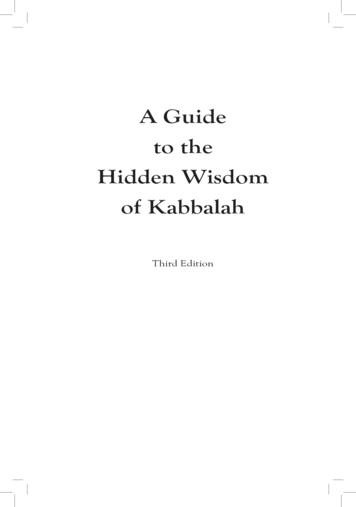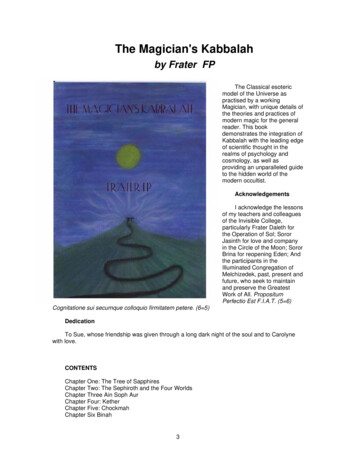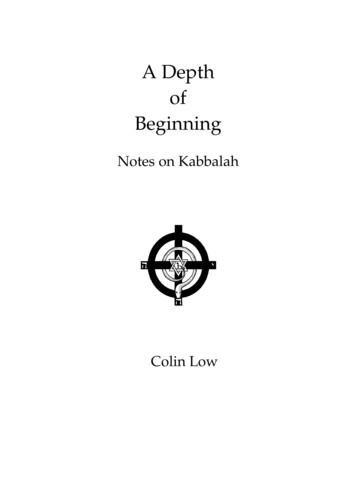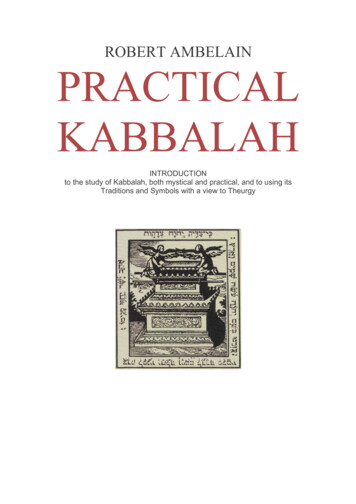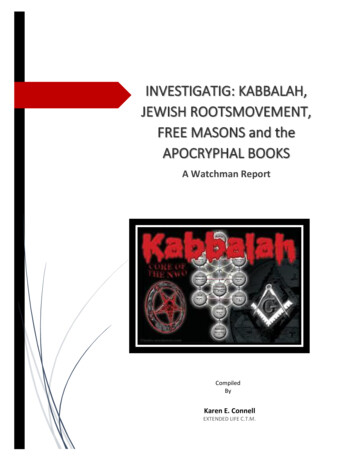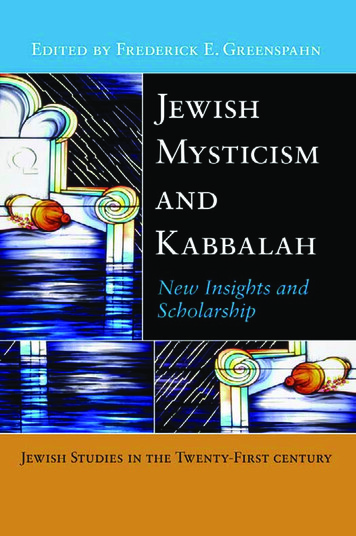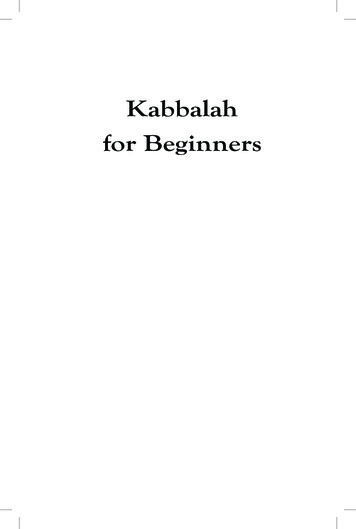
Transcription
Kabbalahfor Beginners
Kabbalahfor Beginners4th EditionLAITMANKABBALAH PUBLISHERSRav Michael Laitman, PhD
Kabbalah For beginnersCopyright 2007 by MICHAEL LAITMANAll rights reservedPublished by Laitman Kabbalah Publisherswww.kabbalah.infoinfo@kabbalah.info1057 Steeles Avenue West, Suite 532, Toronto, ON, M2R 3X1, Canada194 Quentin Rd, 2nd floor, Brooklyn, New York, 11223, USAPrinted in CanadaNo part of this book may be used or reproducedin any manner without written permission of the publisher,except in the case of brief quotations embodiedin critical articles or reviews.Library of Congress Cataloging-in-Publication DataLaitman, Michael.Kabbalah for beginners / Michael Laitman. — 4th ed.p. cm.ISBN 978-0-9781590-9-21. Cabala. I. Title.BM525.L252 2007296.1’6—dc222007021769Research: Eli Vinokur, Oren LeviPhotos: Moshe AdmoniLayout: Richard AquanGraphics: Baruch KhovovCopy Editor: Claire GerusPrinting and Post Production: Uri LaitmanExecutive Editor: Chaim RatzFOURTH EDITION: OCTOBER 2007First printing
K a bb a l a h f o r B e g i n n e r sTa bl e o f C o n t e n t sIntroduction . . 9Part One: The History of Kabbalah. 13Chapter 1: Kabbalah Chronicles. . 15Stage One . . 16Stage Two . . 23Stage Three . . 25Chapter 2: Timeless Teachers of Kabbalah. 27Rabbi Akiva. . 28The Turning Point. 29Discovering the Law of Love. 30The Bar-Kokheva Revolt. 31Two Blows to Rabbi Akiva’s Work. 31Rabbi Shimon Bar-Yochai (Rashbi). 32From Student to Fugitive. 34The Cave at Piqiin. 34One in Millions. 36Isaac Luria (the Holy Ari) 1534-1572. 37A Man of Mystery and Legend. 37Preparing for the Revelation. 38Rabbi Yehuda Leib HaLevi Ashlag (Baal HaSulam) 1884-1954. 40His Major Works. 41Spreading the Word. 43
Part Two: The (Gist of the) Wisdom of Kabbalah. 45Chapter 3: The Origin of Creation. . 47The Spiritual Worlds. 47The Thought of Creation. 48Four Basic Phases (and their root). 49Phase Four – Craving the Creator’s Mind. 54The Quest for the Thought of Creation. 56The Route . . 62Using the Screen. 62Workable and Unworkable Desires. 65The Common Soul. 67The Great Fall. 68Chapter 4: Mending Adam to Achieve Perfection. 71The Pyramid. 74The Making of Life. 75As Above, So Below. 77Up the Ladder. 79Building the Vessel. 82The Desire for Spirituality. 85Phase Four – the Phase of Conscious Evolution. 87Part Three: Talk about Reality. 91Chapter 5: All in One and One in All. 93Three Boundaries in Studying the Upper Worlds. 96First Boundary—What We Perceive. 96Second Boundary—Where We Perceive. 97Third Boundary—Who Perceives. 98Perceiving Reality Correctly.101A Nonexistent Reality. 103The MeasurementMechanism. 105The Sixth Sense. 107Create Your Perfect Reality. 109The Thought of Creation.112Back to the Future.113Two Approaches, Two Paths.114Desire Makes for Progress. 115
Part Four: Crisis and Correction.119Chapter 6: A New Method for a New Desire. . 123The Dark before the Dawn. 123A Brave New World in Four Steps. 128Know Your Limits.131The Reins of Life. 133Changing Society to Change Myself. 135Chapter 7: The Four Factors of Our Make-Up. . 139Choosing the Right Environment for Correction. 142No Room for Anarchists. 146The Ego’s Inevitable Death.147The Cure . . 150Fake Freedom. 152Concealment—a Requisite for Free Choice. 153Implementing Free Choice. 154Faith . . 155Reason . . 155APPENDIXES. . 159Appendix One: Frequently Asked Questions. 160What Is the Wisdom of Kabbalah?. 160What Is Spirituality?. 163The Revelation of the Creator. 164Kabbalah Is Not Mysticism. 166Studying Kabbalah. 168Body, Soul, and Reincarnation. 172Appendix Two: Further Reading. 178Beginners . . 179Intermediate.181Advanced . . 182All Around . . 183Appendix Three: About Bnei Baruch. 186History and Origin. 186The Study Method. 187The Message. 188Activities . . 189How to Contact Bnei Baruch. 192
IntroductionScientists have been studying the laws of Nature, our behhavior, and our place in the world for thousands of years.Yet, these days, scientists are realizing that the more theyadvance in their research, the more confusing they findthe world to be.While science has undoubtedly brought enormousprogress to our lives, there are boundaries beyond whichit cannot penetrate. For instance, scientific tools cannotmeasure the human soul, or the basic motivation for ouractions. If it could, we would be able to “program” peopleto behave as we wish. But because we cannot perceive ourmost essential motivations, we humans, the apex of Creaation, are still unaware of why we come into this world!Man has always been searching for the answers tolife’s most basic questions: “Who am I?” “What is the
10K abbalahfor B eginnerspurpose of my life?” “Why does the world exist?” “Do wecontinue to exist after our physical being has ended?”In the absence of sufficient answers, some find tempporary refuge in Eastern teachings, meditations, or technniques that minimize personal expectations and reducethe suffering caused by disillusionment.However, experience teaches us that we can neversatisfy all our desires; therefore, we will always experieence some degree of discontentment. Yet, at the deepestlevel of our being, the true basis for suffering arises fromour inability to answer life’s most fundamental question:“Why am I here?”Kabbalah answers this very question, and in doingso, guides us toward complete and lasting satisfaction.It teaches us how to access the essential feeling of thespiritual realm—the sixth sense—and thus improve ourlives in this world. With it, we can perceive the UpperWorld—the Creator—and assume control over our lives.The Bible, The Book of Zohar, The Tree of Life, The Studyof the Ten Sefirot, and other authentic Kabbalistic sourceswere given to us to promote us in the spiritual realms.With their help, we can obtain spiritual knowledge. Theyexplain how we can turn our lives in this world into apath to spiritual ascent.Over the generations, Kabbalists have written manybooks in various styles, each adapted to the era in whichthey lived. Similarly, Kabbalah for Beginners has been writtten to help you take your first steps towards understanding
Introduction11the roots of human behavior and the laws of Nature. Thecontents present the essential principles of the wisdomof Kabbalah and describe how these principles work.This book is intended for those searching for a reliablemethod of studying our world. It is written for those seekiing to understand the reasons for suffering and pleasure,who strive to take charge over their lives and make themthe exciting and joyous journeys they can be.* This book is based on essays and lectures given by RavMichael Laitman, PhD, which were then edited by staffmembers of the Ashlag Research Institute (ARI).
Part OneThe Historyof Kabbalah
There is no real difference between the history ofKabbalah and the history of the world, except thatKabbalah tells the same story from the spiritualperspective. It is similar to examining our lives from twovery different perspectives. From the historical perspecttive, our past is a sequence of events that happened to usor to our ancestors, while from the Kabbalistic perspecttive, our past is a sequence of spiritual events, expressedin a series of scenes we call “life on Earth.”As we will see in Part Three, history isn’t really “unffolding” in Kabbalah; rather, it is experienced withineach and every one of us separately. Kabbalists don’t rellate to the external reality as a tangible reality, but explainthat what we perceive as “external” is really a reflection ofimages that exist only within us.Part One of the book will discuss the history of Kabbbalah as experiences that occurred in the physical world.Part Two will explore the origin and structure of reality. PartThree will examine our inner reality, and Part Four combbines all three into one coherent, practical worldview.
1Kabbalah ChroniclesThe Rambam (Maimonides), a great 12th century Kabbbalist, wrote that thousands of years ago, when humanitywas deep in idol worship, one man couldn’t go with theflow. His name was Abraham, and today we know himas “Abraham the Patriarch.” Abraham pondered andsearched until he found the truth: that the world hadonly one leader.When he discovered this, he realized he had unccovered life’s eternal truth, and ran to share it with theworld. To clarify his message, he developed a method thathelped him explain his perceptions more clearly. Sincethen, the world has had a method that reveals this truth.Today this method is as valid as it was then, and we callit “the wisdom of Kabbalah.”15
16K abbalahfor B eginners- P art O neStag e O n eIn Chapter One of his book, The Mighty Hand, Maimonidesdescribes how there was a time when people knew thatthere was only one force governing the world. He explainedthat after some time, due to a prolonged spiritual decline,they all forgot it. Instead, people believed that there weremany forces in the world, each with its own responsibilitties. Some forces were responsible for food provision, somewere meant to help us marry more successfully, and somewere in charge of keeping us wealthy and healthy.But one man, whom we now know as Abraham, notticed that all these forces obeyed the same rules of birthand death, budding and withering. To discover what thoserules were, he began to study Nature. Abraham’s researchtaught him that there was really only one force, and everytthing else was only a partial manifestation of it. This wasStage One of the spiritual evolution of humanity.JPerhaps one of the best known Native Americantraditions is the Council Circle. Here, the memberssit in a circle, each member expressing a different aspectof the same issue. Similarly, Abraham didn’t want to seethings only from his perspective. He wanted to see througheveryone’s eyes, and thus discover the one force thatmade different people see different things.Once Abraham discovered this truth, he beganto spread the word. Challenged by having to explaina concept that contradicted everything his contempor-
Chapter 1: Kabbalah Chronicles17raries believed, Abraham was forced to develop a teachiing method that would help him reveal this concept tothem. This was the prototype of the teaching methodwe now call “Kabbalah” (from the Hebrew word, Lekabbbel, to receive). Today, Kabbalah teaches us how to disccover the force that guides us, and in doing so, receiveinfinite joy and pleasure.We will talk about Abraham’s discovery in greaterdetail later in the book, but we should mention here thatthe essence of his discovery is that the universe is “obeyiing” a force of love and giving. This force is what Abrahham and all the prophets in the Bible call “The Creator.”When Biblical figures speak of the Creator, or the Lord,or God, they speak not of a being, but of a force of loveand giving, and how they perceive it. If we keep this inmind, we will find the method of Kabbalah very clearand easy to understand.Abraham’s discovery was no coincidence. It arrivedjust in time to counter an outbreak of egoism and selfishnness that threatened to destroy both the love and unityamong people, and between humankind and the Creator.This unity was the natural way of life for humanityprior to the time of the Tower of Babel. This is what theBible means by, “And the whole earth was of one langguage and of one speech” (Genesis 11:1). Everyone knewabout the Creator, the force of love and giving, and allwere united with it. People experienced it as part of theirlives, and they didn’t need to “work” on their unity, as isdone today, because no egoism was setting them apart.
18K abbalahfor B eginners- P art O neThis is why the Bible writes that they were of “one langguage” and “one speech.”But as soon as people’s egoism began to develop,they wanted to use their unity for their own benefit. Thisprompted the Creator’s concern. Put differently, theforce of love had to act to counter humankind’s egoismcaused separation. In the words of Genesis, “The Lordsaid, ‘Behold, they are one people, and they all have thesame language. and now nothing which they purposeto do will be impossible for them’” (Genesis 11:6).To save humanity from its own egoism, the Creator,the single force discovered by Abraham, could do one oftwo things: disperse humanity and thus prevent a catasstrophic clash of self-interests, or teach people how toovercome their egoism.The latter option offered an obvious benefit: if peopple remained united despite their egoism, they would notonly retain their way of life, they would actually uniteeven more closely with the Creator. In other words, theefforts to bond, despite their growing egoism, wouldforce people to become much more aligned and unitedwith both the Creator and each other.Here’s an illustration of this principle: Imagine youare rich and want a shiny new Jaguar. This is no big deal;you just walk into the nearest dealership and come outdriving the car of your dreams. How long do you thinkyour pleasure would last? A week? Probably even less.And how much would you really care about your new
Chapter 1: Kabbalah Chronicles19Jag, which demanded nothing more than a visit to thedealership to get it?But if you were not well off and had to work twoshifts for two whole years to get that Jaguar, you wouldundoubtedly love and appreciate your car very much.The effort you put into “attaching” yourself to it wouldmake that car much more important to you.This is the benefit of bonding with the Creator desspite growing egoism. Egoism serves an important purppose: it is there to give you something to strive to overccome, a “practice field” where you can make efforts thatwill make you appreciate the force of love—the Creator.(Abraham thought): “‘How is it possible that thiswheel will always steer without a driver? And whoJis driving it? After all, it cannot drive itself!’ And he had noteacher, and no one to let him know. Instead, he was surrrrounded by idolaters, fools. And his father and his mother,and all the people were idolaters. And he, too, was idolworshipping with them. And his heart roamed and undersrstood, until he attained the path of truth.”--Maimonides, Yad HaChazakah (The Mighty Hand), Idolatry RulesSo the Creator revealed Himself to Abraham to showhim how humanity could “practice” and “work” at lovingthe Creator, and thus become closer to Him. This is alsowhy Abraham was such an enthusiastic disseminator ofhis method. He knew that time was of the essence: eitherhe taught his people how to unite through bonding with
20K abbalahfor B eginners- P art O nethe Creator—the force of love—or their growing egoismwould alienate them from one another and they woulddisperse or kill each other off.As the Bible and other ancient Hebrew texts teachus, the Babylonians rejected and scorned Abraham’s offfer. Abraham confronted their king, Nimrod, and provedthat his method could work. But instead of adopting it,Nimrod attempted to assassinate Abraham. Now, withhis life at stake, Abraham fled from Babylon and beganto teach his method while roaming “from town to townand from kingdom to kingdom, until he arrived in theLand of Israel” (Maimonides, The Mighty Hand, IdolatryRules, Chapter 1).Despite hardships and challenges, Abraham’s teachiings gained some support, and his followers helped himshare his knowledge with others, filling the ranks with“new recruits.” In time, the lone fighter for truth hadmultiplied, creating a nation whose name, “the nation ofIsrael,” symbolizes the one thing they had in common—their desire for the Creator. The word “Israel” is really acombination of two Hebrew words: Yashar (straight) andEl (God). The people of Israel are those who have onedesire in their hearts: to be like the Creator, united byaltruism and love.The collapse of the Tower of Babel was not, howeever, the end of the story, but only the beginning. Theforce of love, which Abraham had discovered, wanted totighten its bond with humanity. But since the Creator isa force of love, and loves us as much as anyone can love
Chapter 1: Kabbalah Chronicles21another, the only tightening of the bond can come fromus. Hence, this force, the Creator, keeps increasing ouregoism, so we may rise above it by strengthening our tieswith Him.For those who want to remain egoists, increasedegoism means greater alienation. As a result, the peoplewho were once united split into different nations andinvented new technologies with which they could createnew weapons. They used these weapons to protect whatthey thought was their freedom, but which was actuallytheir increased self-centeredness and alienation from theCreator and from one another.Without noticing it, they became increasingly subjuggated to their egoism while mistakenly thinking they weredefending themselves from those who wanted to harmthem. Their egoism made them forget that when theywere united, they hadn’t needed weapons, as they had noegoism to make them feel their freedom was threatened.But those who wanted to remain united, and evendeepen their bond of love, treated their increased egoismas an opportunity for growth. To them, it was a welcomechallenge, rather than a problem or crisis.But to cope with their heightened egoism they needeed to upgrade Abraham’s method. This was Moses’ cue.As with the Babylonians and their king, Nimrod, overccoming the new level of egoism—this time representedby the Egyptians and their king, Pharaoh—meant escapiing it.
22K abbalahfor B eginners- P art O nePharaoh wasn’t simply an evil king. He actuallybrought Israel (those who want the Creator) closer to theCreator. In Kabbalah, Pharaoh is the epitome of egoism,and the only way to escape him is to unite (with eachother and with the Creator). As we’ve seen before, unitymakes you closer (more similar) to the Creator. To deffeat Pharaoh, Moses returned to Egypt after his escape,united the people around the same idea that Abrahampromoted many years previously, and once again helpedhis people escape.But this time, Israel defeated a much more powerfful ego. Pharaoh was not like Nimrod, King of Babel; hecould not be defeated by one determined man. DefeatingPharaoh required a whole, united nation. And becauseMoses needed to teach Abraham’s method to a whole nattion, he wrote a new book, an adaptation of Abraham’steachings for an entire nation: The Torah (Pentateuch).But the Creator, being a force of love and generosity,wanted to give more than to just one nation. He wantedthe whole world to know that there was only one force andthat they would take the gift He wished to give humaniity—Himself.So while Moses’ Torah was a big step forward, sinceit helped a whole nation connect with the Creator, itwas not the end of the road. The end of the road willarrive only when the whole world is in touch with Him,experiencing the bond of love and unity that the ancientBabylonians did, before the first outbreak of egoism. Put
Chapter 1: Kabbalah Chronicles23differently, the end of the road will arrive when all ofhumanity reclaims what it once had, and then lost.In the article, “The Essence of the Wisdom ofKabbalah,” Kabbalist Rabbi Yehuda AshlagJdescribes the purpose of Creation as a “single, exaltedgoal described as ‘the revelation of His Godliness to Hiscreatures in this world.’”Stag e T woThe second stage in humanity’s spiritual evolutionstarted about two thousand years ago, when The Book ofZohar, the most important book of Kabbalah, was writtten and then concealed. It was written shortly after thepeople of Israel were exiled for what was to be their lastand longest exile.Just like Abraham and Moses in Stage One, the secoond stage had two giants of its own: Rabbi Shimon BarYochai (Rashbi) and The Holy Ari (Rabbi Isaac Luria).Rashbi’s Book of Zohar is, as the book itself states, a commmentary on the Torah. Just as Moses explained Abraham’swords to the entire nation, The Book of Zohar is intended toexplain Moses’ words to the entire world. This is why oneoften reads that The Book of Zohar is destined to appear inthe time of the Messiah, at the “end of days.” It is also whyRabbi Yehuda Ashlag, the great twentieth-century Kabbaliist, wrote that the rediscovery of The Book of Zohar is proofthat the “days of the Messiah” are here.
24K abbalahfor B eginners- P art O neAs always, the only antidote to a rise in egoism isunity, and the greater the egoism, the more importantit is for people to unite. At first, uniting Abraham’s folllowers and family was enough. Then, when Moses fledfrom Egypt, he had to unite a whole nation in order tosucceed. Today, we need to unite the whole of humaniity. Egoism has reached such intensity that unless thewhole of humankind unites to overcome it, we will notsucceed.J“I have found it written that the above decree tonot openly engage in the wisdom of truth was onlyfor a time—until the end of 1490. From then on the sentrtence has been lifted, and permission has been given toengage in The Book of Zohar. And from the year 1540 it hasbecome praiseworthy to engage in great numbers, since itis by this virtue that the Messiah King will come, and not byanother virtue.”-- Rabbi Avraham AzulaiIntroduction to the book, Ohr ha Chama (Light of the Sun)The second stage in the process of humanity’sbonding with the Creator was very different from thefirst. It was a time of subtle growth, when the tool tounite humanity—the wisdom of Kabbalah—was beingrefined and improved in dimly lit rooms and withinsmall, inconspicuous groups. This is why the two mostsignificant works of that period, Rashbi’s Book of Zoharand the Ari’s Tree of Life, were hidden by their own aut-
Chapter 1: Kabbalah Chronicles25thors as soon as they were completed. They resurfacedmany years later, and in the case of The Zohar, manycenturies later.Stag e T h r e eThe third and last stage of humanity’s spiritual evoluttion began in the 1990s. In 1945, Rabbi Yehuda Ashlag,author of the Sulam (Ladder) commentary on The Book ofZohar, predicted that the final stage would begin in 1995.Similarly, the Vilna Gaon (GRA) wrote in his book, TheVoice of the Turtledove, that this stage would begin in1990. Many other Kabbalists made similar predictions,leading to the conclusion that the future is already here,and now is the time to unite as one and defeat egoismonce and for all.Humanity’s entire history is paved with battlesagainst egoism, followed by attempts to unite despite it.Today, most scientists agree that man’s self-centerednessand misunderstanding of Nature’s rules are the causesof all that is wrong with our world. Yehuda Ashlag wroteabout this in the 1930s and 1940s, but in those days, hewas a voice in the wilderness.In recent years it has become evident that unless wechange ourselves, the world will not change for the bettter. In fact, we are ruining our planet and our society inso many ways that solving the problems separately hasbecome impossible. To solve our problems, we need aninclusive solution, which can only be found when we
26K abbalahfor B eginners- P art O netransform human egoism into altruism, and bond withthe force of love—the Creator.In his article, “Peace in the World,” Ashlag writesthat if we unite, every single member of humankind willpersonally experience the Creator in the deepest sense ofthe word, as it is written, “they shall all know Me, fromthe least of them unto the greatest of them” (Jeremiah31:33). The wisdom of Kabbalah has been prepared as amethod that can help us do just that—unite—and experieence the Creator. In his “Introduction to the Book ofZohar,” Ashlag wrote that if we integrate Kabbalah intoour day-to-day lives, we will achieve the goal for whichwe were created, and we will again be “of one languageand of one speech,” at one with the Creator, and we willnever to part again.
2Timeless Teachers of KabbalahThrough the ages, many Kabbalists have written proffound and beautiful books. But we would like to focuson four very special Kabbalists and their books. Thesemen wrote
Kabbalah and the history of the world, except that Kabbalah tells the same story from the spiritual perspective. It is similar to examining our lives from two very different perspectives. From the historical perspec-tive, our past is a sequence of events that happened to us
